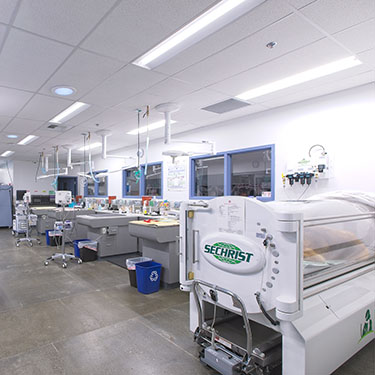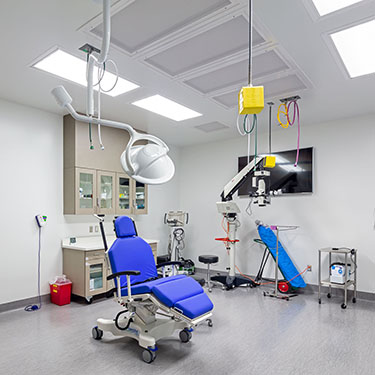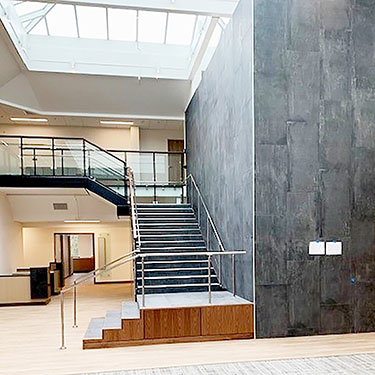|
Subscribe / Renew |
|
|
Contact Us |
|
| ► Subscribe to our Free Weekly Newsletter | |
| home | Welcome, sign in or click here to subscribe. | login |
Construction
| |
 |
May 11, 2023
Considerations for successful adaptive reuse projects
Aldrich + Associates

Ward
|
It’s been highly publicized that Washington hospitals and health care institutions are in a tough place. They are experiencing financial strain, reporting more than $2 billion lost in 2022. Ongoing burdens of the pandemic, rising costs for supplies, and increasing personnel costs, as labor is in short supply and high demand, are all contributing factors. There’s also an ongoing shortage of beds and continued congestion in emergency rooms, further exacerbating the problem and the imperative of getting people the care they need.
While the costs of health care continue to be a much-discussed topic, institutions are also grappling with how to take action. At the recent Health Care of the Future event hosted by the Puget Sound Business Journal, Ketul Patel, CEO of Virginia Mason Franciscan Health, highlighted the need to improve the intake process at the ER to divert patients to the appropriate level of care. Part of this solution is also increasing care at the community level. You can readily see this strategy taking hold with more urgent care clinics and ambulatory facilities opening in suburbs as well as more rural communities. Many of these facilities are using former retail or other commercial buildings that were not initially intended for health care use.
While not a new concept, adaptive reuse for health care seems to be gaining greater traction. It brings several advantages to increasing community-based health care options, such as speed to market, overcoming a lack of real estate available for development, and reduced capital investment.
ADAPTING TO ADAPTIVE REUSE
Aldrich has been converting office and retail facilities to health care use for decades. From a Ross department store turned ambulatory surgery center, Walgreens pharmacy turned veterinary hospital, Circuit City retail store turned multi-specialty clinic, we’ve been part of making adaptive reuse an effective strategy for many facility types.
From the outside, many existing facilities look perfect for health care applications — conveniently located, open floor plans, and ample parking for staff and patients. However, when changing a building’s use, there is more than meets the eye; most of these buildings lack the necessary infrastructure to effectively serve a health care program. It is important to accurately anticipate the infrastructure requirements early so that the owner can make informed decisions before making a significant investment.
As an experienced health- and sciences-focused contractor, we play an important role in helping these essential organizations make business decisions about their facility needs and options. We provide feasibility studies and systems conditions investigations to inform acquisition decisions, partner with design teams early to provide accurate early estimates and budgeting for renovations and system upgrades, and follow through with quality construction to bring these new facilities to life.
There are unique considerations for all medical facility projects that design teams and contractors must address to create a facility that successfully meets their requirements and delivers a positive patient experience — for both human and animal patients! Several of our recent adaptive reuse health care projects demonstrate these considerations:
UNDERSTANDING STRUCTURAL REQUIREMENTS
Many existing office buildings are light-frame structures with limited floor-to-floor height, requiring close assessment and often upgrades to accommodate medical uses and required infrastructure. For example, Proliance Orthopaedics & Sports Medicine (POSM) celebrated the grand opening of its new Bellevue clinic in late February, which was an adaptive reuse project converting a three-story commercial building into a clinic. Prior to purchasing the building, we worked with POSM on its feasibility study to assess suitability for creating a clinic, PT, imaging (X-ray, MRI, CT), and an ambulatory surgery center. Our team studied the integrity of the exterior envelope, HVAC systems, electrical service, and structural systems.
The initial program desire was to include an ambulatory surgery center; however, the light framing and limited floor-to-floor height led the team to advise against this but still maintain clinical, imaging, and PT. This still required creative logistics and design to navigate, including additional structural considerations to support lead shielding for X-ray imaging equipment, lowering the floor to accommodate the MRI machine, and innovated and intentional routing and locations for MEP distribution equipment and infrastructure.
The opposite but equally challenging structural condition often occurs in retail facilities. Since most retail buildings have a high floor-to-structure height (often up to 25 feet), design and construction teams need to find creative solutions for the plethora of ceiling-mounted equipment for imaging rails and surgery lights. Utilizing a self-supported structure can be an efficient alternative to trying to attach to the existing roof structure.
EXISTING UTILITY SERVICES
Medical facilities require significant utility infrastructure to serve specialty equipment. The costs of system upgrades and modifications can outweigh the capital investment savings of purchasing an existing structure. For example, the Animal Medical Center of Seattle adapted a Walgreens retail pharmacy building into an emergency veterinary facility in Shoreline. Prior to the client landing on this location, we provided high-level constructability feedback on other potential sites. While several seemed promising, these due diligence investigations revealed that the modifications required for reuse were going to be too financially challenging.
The key to informing our client’s evaluation of multiple sites was using our experience to accurately anticipate the facility upgrade requirements and provide rough order-of-magnitude pricing to help avoid budget surprises later.
Careful consideration needs to be made for the existing utility services. Most adaptive reuse projects for health care require an upgrade to the electrical service to meet the higher demand of specialty equipment. Also, depending on the specific program, domestic water service may also need to be increased. These factors can be a significant cost and schedule challenge when working with utility providers.
The Animal Medical Center of Seattle included larger-capacity HVAC systems and MRI, CT, and X-ray imaging equipment, requiring a significant electrical service upgrade. The subsequent annex project for the veterinary hospital required upgrades to the domestic water service and new fire water service and sprinklers. All major cost considerations to the owner’s business plan.
REVITALIZING COMMUNITY HUBS
Northgate Mall in north Seattle has been completely transformed in recent years, anchored by the demolition of the mall and the addition of the new Kraken Community Iceplex. Northgate Plaza across the street has experienced its own revitalization as well, part of which was renovating the ground-floor former Ross Dress for Less store into a surgery center for Northwest Eye Surgeons.
The existing Ross space was located in the midst of a multi-story retail development, and the surgery center required new dedicated HVAC equipment and an emergency power generator to meet requirements for the Department of Health. Locating the new equipment and running the utility connections became a significant challenge and required creative solutions and negotiation with the landlord. The emergency generator and fuel tank were particularly challenging with limited options for security, safety, noise, vibration and exhaust. Understanding these unique requirements and working with the fire marshal and local jurisdiction early in the process is critical.
By reusing this retail building that was already integrated in the Northgate community, Northwest Eye Surgeons created ready access to its services.
A WORTHY CAUSE
Speed to market is often considered the primary value of adaptive reuse. However, we see the value going much deeper — care organizations are able to progress their goals for more accessible care, with the added benefit of revitalizing neighborhood developments that otherwise might be run down or sit vacant.
Space and funding are finite resources. Partnering with owners and designers to creatively maximize the value of both in ways that enrich the community is a truly rewarding aspect of constructing adaptive reuse projects for health and wellness providers.
George Ward is president of Aldrich + Associates. With 30 years’ experience in the construction industry, Ward leads Aldrich’s business development and is an active project leader, supporting teams through the full project lifecycle.
Other Stories:
- Why Seattle has become a hotbed for life sciences
- New chapter for life sciences starts in the U District
- Tepid appetite for local lab space continues
- What does it take to convert offices to biotech lab space?
- Best practices for successful outcomes to complex health care projects
- ‘Supersized’ team finds success at Seattle Children’s Forest B
- Wellness nestles in the trees at The Evergreen State College
- Transforming the care model in the Rogue Valley
- The evolution of science: trends affecting the science workplace





